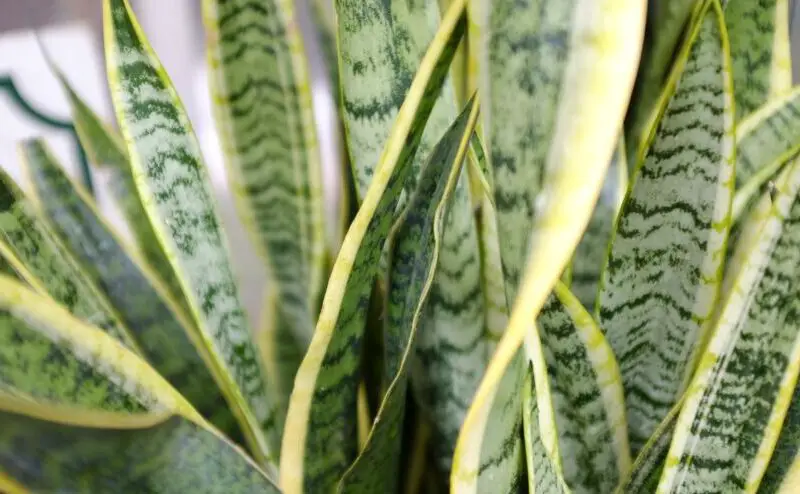The snake plant, also called sansevieria, is what one calls “a succulent”. Its evergreen foliage in rigid tuft is usually olive green, marbled or bordered with yellow or white. The 6 to 10 cm wide, thick leaves have a non-prickly thorn at the tip that allows them to grow.
They can be erect, flat, triangular, sword-shaped or cylindrical. The species can be tall or dwarfed, varying from 0.15 to 1.80 m and more in height. The snake plant flowers after long years of cultivation. It gives then in spring or summer of very numerous yellow green or white flowers, scented and joined together in bunches.
Contents
How fast do snake plants grow ?
Its growth is slow and, depending on the species, its size can vary from 0.15 to 1.80 m in height, the leech will be discreet. It requires very little care. An accentuated sunning will allow it to grow a little faster than the average.
The benefits of having a snake plant
When you buy a plant, it is above all to decorate your interior. But did you know that some plants do not only play the role of “green plant”? Indeed, our famous snake plant has some other qualities. Indeed, the snake plant is what one calls “a depolluting plant”.
It purifies your interior. The leaves of the snake plant play the role of a filter. They absorb harmful substances and redistribute oxygen. The air in your room is thus purified. This is excellent for the respiratory system, the skin, the eyes… Placed in a room, and considering this property, the snake plant can contribute to improve your sleep.
Growth of the Snake Plant
The snake plant is an accommodating plant that is suitable for the majority of exhibitions in an apartment. However, it prefers a bright light and even a little full sun so as not to wither away. It is not a very attentive plant in terms of watering, it is possible to forget it a little without risk of seeing it immediately perish.
The snake plant should be cultivated in a large pot pierced in its bottom and lined with a bed of gravel or clay balls to ensure good drainage. The culture mix should be light. It will be composed in equal parts of potting soil, garden soil and river sand of medium granulometry.
Height and space required
The snake plant is a plant which has a slow growth. According to its variety, it can measure between 30 and 150 cm.
Type of soil
A well-draining soil mixture is preferred. You can also place pieces of gravel or clay balls at the bottom of the pot to facilitate water drainage. Avoid using a pot that is too large, as the leash likes to be cramped.
Exhibition
The snake plant needs good light, but without direct sunlight. That said, being a plant not very demanding, it also adapts itself to the darker interiors. On the other hand, in more shady environments, the snake plant will grow more slowly.
This plant likes the hot temperatures and supports the cold very badly. The temperature of a house or an apartment is ideal because it must be included/understood in 18 and 21° all the year.
The snake plant fears the temperatures lower than 12°.
Fertilizer supply
If you regularly add topsoil, fertilizer is not necessary. You can, however, dilute a liquid green plant fertilizer in water throughout the summer. Fertilize every other watering can.
Leaf maintenance
On the maintenance side, it’s quite easy: just remove the dry leaves as you go along. To remove the dust that accumulates on the large leaves, pass from time to time and from bottom to top a soft cloth soaked in soapy water. That’s it!
Watering the snake plant
The sansevieria (snake plant) is watered about once a week. It is important that the substrate has had time to dry between waterings, because although this plant tolerates drought well, it is very fragile to excess water. It is therefore important not to let water stagnate at the bottom of the pot saucer. We also fertilize occasionally.
During the growing period, water once a week, but never leave standing water in the saucer. Add a little green plant fertilizer every two weeks.
In winter, watering should be very sparing; let the mixture dry in between and stop adding fertilizer to allow for a rest period. Remember to clean the leaves to remove dust that could block gas exchanges.
The leech can take its summer quarters outside as soon as the temperatures are mild. Then acclimatize it gradually in full sunlight. This plant can tolerate a temperature of 7°C, you will thus return it as of the first frosts.
Growth rate of the snake plant
But beware, if the snake plant tolerates low light, it is not strictly speaking a shade plant. The more light it receives, the more it will grow,” explains Jérôme Lin. If it is too much shade, it will stagnate and, after a few years, the plant will look a little frail. “And under these conditions, there’s no chance it will flower.
In its natural environment, the snake plant receives a lot of light.
Native to the arid regions of Africa and Asia, this succulent tolerates low ambient humidity, which makes it particularly well suited to our dry interiors in winter. It is a very resistant plant thanks to its thick leaves which will store water.
Flowering of the snake plant
Snake plants rarely flowers when grown indoors, and only under good conditions. One then sees the appearance of an inflorescence of several small flowers in the form of stems, of a white/pale yellow color.
Diseases and parasites attacking the snake plant
The sansevieria (i.e snake plant) is a very resistant plant and little subject to the diseases. The excess of water is what can really harm it and cause the plant to rot. We will then see the leaves become soft and hanging, while the stems will sag.
Also, a lack of light will cause the leaves of the snake plant to turn pale.
Few pests and insects attack the snake plant, except the mealy bug.
It is best to keep the sansevieria out of the reach of children and animals, given its toxic potential.
Which land for the snake plant?
The snake plant likes bright exposures, without being directly exposed to the sun. But if you want to pamper it, prepare a floor that will please it. Even if it is not really difficult, it particularly appreciates well-drained soils.
Whether it is at the time of your purchase or at the time of its repotting (which must be carried out obligatorily every 3 years), it is necessary to let it evolve in a ground made up of a mixture of compost, of free ground (in equal parts), peat and sand with average granulometry.
Or take some soil from your garden and mix it with some gravel or clay balls to aerate it. Your snake plant will be very grateful.
When, how to repot?
Repot the strap every 3 years at the most or as soon as the roots of the plant fully occupy the volume of the pot. Choose a new, slightly larger container: mother-in-law’s tongue likes to be cramped.
Use a rich and well-draining soil. It must contain at least 1/3 of sand or pozzolana.
Multiply the strap
The snake plant can multiply by cutting leaves, but if you have a variety with variegated or marbled foliage, you risk seeing its beautiful golden colors disappear.
To avoid this, prefer division: in spring, remove your sansevieria and examine the rhizome. Detach the shoots with developed roots and place them in a pot filled with a sandy substrate.
Conclusion
The snake plant is thus a fat plant with a rather slow growth, in spite of its robustness, it should not be exposed to temperatures lower than 12°C. It grows wild in the rocky soils of tropical and subtropical Africa, Madagascar, India and Indonesia. It is cultivated for its long, linear, fleshy, upright and vertical leaves. The leaves are dark green with yellow margins and marbled with lighter green. Very graphic the plant can find its place as well in a contemporary interior as in a more traditional housing. Very resistant, it is to advise all the beginners.
This rhizomatous perennial can adopt three principal forms: in low rosette, erect or arborescent. The leaves can be plain, but also striated or marbled according to the varieties and species. They have the particularity of ending with a thorn that we will be careful not to break, at the risk of stopping the growth of the strap. If your mother-in-law’s tongue likes you at home, it will reward you with a white, sometimes fragrant bloom and decorative bracts.








